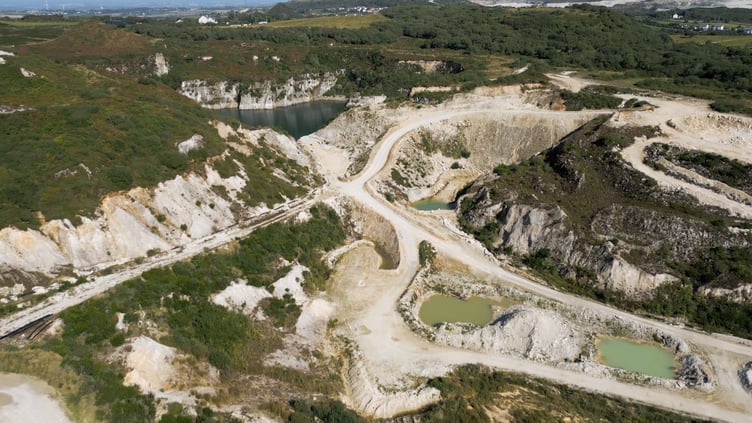IN the scarred landscape of the Clay Country, a quiet revolution has been bubbling below the surface – and it has just switched up a gear.
On Friday, October 18, Lord Falmouth presided over the ceremonial opening of Cornish Lithium’s hard-rock demonstration plant at Trelavour Pit, near Treviscoe, before dignitaries and members of the business community.
A miniature version of an industrial-scale commercial lithium production facility, since 2019 the plant has been preparing to showcase the quality of Cornish lithium to potential customers.
It can now start manufacturing samples, and if demand is as eager as anticipated, it will be primed to upscale with a view to extracting 10,000 tonnes annually to UK and international markets by 2027, creating 300 jobs and generating £800-million for Cornwall over the next 20 years.
Lithium plays a pivotal role in the long-life, rechargeable batteries that power cars, mobile phones, laptops and so many other 21st-century must-have appliances. The UK supply is currently sourced entirely from China, which is the world's largest lithium consumer and produces more than two-thirds of lithium-ion batteries.
Australia is the largest producer and exporter of lithium, while Chile has the largest reserves. But Cornwall is one of western Europe’s key locations for lithium deposits. Utilising resources closer to home can keep carbon footprint to a minimum, and also protects supply from geopolitical changes that might lead to sudden disruptive shortages. That’s why in September, the UK government designated Cornish Lithium’s work at Trelavour Pit as a development of national significance.
Chief executive Jeremy Wrathall said he was “hugely proud”, adding: “It feels amazing to be on the next step in a journey which began in 2016 when we licensed the technology. We have been planning this moment since then, and have spent £15million to get to the point of producing commercial samples of lithium hydroxide for the automotive battery industry.
“It’s exciting to be getting on with the job. It’s like a big chemistry set that can be tested, tweaked and improved.”
The exploration of lithium is just the latest incarnation of Cornwall’s industrial heritage. Jeremy describes Cornish Lithium as “standing on the shoulders of giants” like Richard Trevithick, the Cornish-born engineer who pioneered steam-powered transport in the 19th century.
“Cornwall has been producing tin for 4,000 years, and China clay for 250 years. Lithium is the next step. It’s here, it’s needed and the government recognises the opportunity.”
While the west and east of the county is dotted with the picturesque remains of engine houses from tin and copper mines, in Clay Country — as the area between St Austell and St Dennis is known — the landscape bears witness the presence of kaolin, which is used in everything from pottery to paper, light bulbs to toothpaste.
From the viewing platform, Trelavour Pit resembles any other china clay site: a contrasting landscape of white clay banks and conical spoil tips, surrounded by lush regrowth of ferns and grasses.
The site has been recycled and repurposed as Cornish Lithium’s hard rock arm (it also has geothermal sites in locations including Twelveheads and Tolgus). Quarry manager Jason Earl hands me a lump of granite — a mix of minerals including feldspar, quartz and a dark layer of mica rich in lithium. The mineral deposits will be crushed, milled and filtered to produce lithium hydroxide, which resembles table salt.
The existence of lithium in Cornwall has been apparent since 1864 — during the Second World War, it was used in scrubbers that removed carbon dioxide (CO2) from the air in submarines to create a safe environment for breathing. But for the most part, lithium was simply a waste product in the pursuit of the white stuff, its perceived usefulness limited — until the inexorable rise of the electric revolution.
In the main facility, process manager Dai Moseley describes Trelavour as “a two and a half year engineering journey from empty building to cutting-edge modern technology.”
Dai’s history with Trelavour goes back to 1996, when he joined Imerys as a student and saw the site commissioned as a clay filtration drying plant. With his lengthy experience in the industry, he’s enthusiastic and confident that Cornish Lithium will achieve its goal of supplying top-quality product to a growing market.
“This is a major step forward in green technology,” he says. “The lithium industry is racing forward to keep up with the electric car world. There just isn’t enough supply globally.
“The main purpose of the plant is to make big enough samples to show the end user that we can make the right quality. This is our chance to demonstrate that we can make something real that can be used.”
In villages like Treviscoe, the terraces that housed hard-working communities are reminiscent of those found in the Welsh Valleys. But while jobs might once have been of a dirty and dangerous nature, the kind of work a plant like this will sustain is different but no less important.
Modern mineral extraction, open-cast rather than underground, bears little resemblance to its forebear. Outreach to schools will encourage children to think seriously about the science GCSEs that will enable them to become lab technicians, while training programmes are already in place and apprenticeships are on the cards.
“We are creating the skills infrastructure and economic benefits from scratch,” says Jeremy.
Meanwhile, as many ancillary services as possible are contracted out to local companies, from excavator drivers and electricians to catering and laundry. Even local shops and cafes have reported an uptick in trade as a result of the increased activity on site.
Keeping the community on board is important. A permissive footpath skirting the quarry boundary has been created between St Dennis and Whitemoor, and is popular with dog walkers, cyclists, joggers and even horse riders.
A visitor centre opened in July, and has welcomed local residents and Rotary Club members as well as hosting events for groups including Women In Mining. A community information day on Saturday was sold out.
Exhibition boards follow the industrial history of the area, and an impressive mineral collection has been donated by the family of St Stephen-in-Brannel man Douglas Creba (bardic name: Den an Carrygy, Man of the Rocks).
As stakeholder engagement coordinator, Chloe Bayliss has become the focal point for communication with the local community. She shows schoolchildren how the flotation tanks work similar to a bubble bath: the bubble layer is scooped off because it contains the mica (represented by glitter).
Chloe has also overseen events including litter picks and fingerpost restoration, and even helped to store and clean St Dennis’ church bells during the recent tower renovations.
“It’s important for us as a company to do it right and listen to people,” she says. “That includes what it looks like when it’s complete — the legacy we leave.”
To that end, Jeremy recalls a conversation with a Treviscoe resident who asked what good the plant would do for the village: “I asked her; if we don’t do this, will Treviscoe be better off in five years’ time? She said I had a good point.
“People think Cornwall is a seaside place, but in communities like St Austell and St Dennis, what hope is there? In that light, this is a big opportunity for Cornwall, and it’s very exciting. There will inevitably be disruption and change, but there is no positive transition without change.”





Comments
This article has no comments yet. Be the first to leave a comment.